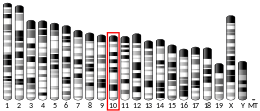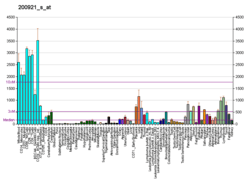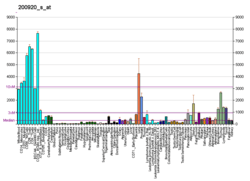BTG1
Protein BTG1 is a protein that in humans is encoded by the BTG1 gene.[5][6]
Function
The BTG1 gene locus has been shown to be involved in a t(8;12)(q24;q22) chromosomal translocation in a case of B-cell chronic lymphocytic leukemia. It is a member of a family of antiproliferative genes. BTG1 expression is maximal in the G0/G1 phases of the cell cycle and downregulated when cells progressed through G1. It negatively regulates cell proliferation.[6]
Interactions
BTG1 has been shown to interact with:
Clinical relevance
Recurrent mutations in this gene have been associated to cases of diffuse large B-cell lymphoma.[13][14]
Maintenance of adult neural stem cells
Recent data, obtained in a new model of mouse lacking the BTG1 gene, indicate that BTG1 is essential for the proliferation and expansion of stem cells in the adult neurogenic niches, i.e. the dentate gyrus and sub ventricular zone (see for review[15]). In particular, BTG1 keeps adult neural stem cells in quiescence, preserving the neural stem cells pool from depletion. In the absence of BTG1, the stem and progenitor cells initially hyper proliferate and then in the longer period lose the ability to proliferate and expand.[16][17] Other recent data indicate that physical exercise can fully reconstitute the proliferative defect of stem cells that follows the ablation of the BTG1 gene, suggesting that the pool of neural stem cells maintains a hidden form of plasticity which is tightly controlled by BTG1; hence, BTG1 might prevent the depletion of stem cells in the presence of strong neurogenic stimuli or of neural degenerative stimuli.[18][19]
Btg1 plays a role also in the expansion of cerebellar granule precursor cells. In fact the deletion of Btg1 leads in mouse to uncontrolled proliferation of the cerebellar precursor cells during the early postnatal period. Consequently, in the adult, the cerebellum lacking Btg1 is significantly larger and the motor coordination is heavily impaired.[20]
The closest homolog of BTG1 is BTG2, which also controls the proliferation and differentiation of adult neural stem cells; the role of BTG2, however, appears to differ from that of BTG1 being probably more relevant in controlling the terminal differentiation of neural stem and progenitor cells in the adult neurogenic niches.[17]
References
- GRCh38: Ensembl release 89: ENSG00000133639 - Ensembl, May 2017
- GRCm38: Ensembl release 89: ENSMUSG00000036478 - Ensembl, May 2017
- "Human PubMed Reference:". National Center for Biotechnology Information, U.S. National Library of Medicine.
- "Mouse PubMed Reference:". National Center for Biotechnology Information, U.S. National Library of Medicine.
- Iwai K, Hirata K, Ishida T, Takeuchi S, Hirase T, Rikitake Y, et al. (April 2004). "An anti-proliferative gene BTG1 regulates angiogenesis in vitro". Biochemical and Biophysical Research Communications. 316 (3): 628–35. doi:10.1016/j.bbrc.2004.02.095. PMID 15033446.
- "Entrez Gene: BTG1 B-cell translocation gene 1, anti-proliferative".
- Bogdan JA, Adams-Burton C, Pedicord DL, Sukovich DA, Benfield PA, Corjay MH, et al. (December 1998). "Human carbon catabolite repressor protein (CCR4)-associative factor 1: cloning, expression and characterization of its interaction with the B-cell translocation protein BTG1". The Biochemical Journal. 336. 336 ( Pt 2) (2): 471–81. doi:10.1042/bj3360471. PMC 1219893. PMID 9820826.
- Prévôt D, Morel AP, Voeltzel T, Rostan MC, Rimokh R, Magaud JP, et al. (March 2001). "Relationships of the antiproliferative proteins BTG1 and BTG2 with CAF1, the human homolog of a component of the yeast CCR4 transcriptional complex: involvement in estrogen receptor alpha signaling pathway". The Journal of Biological Chemistry. 276 (13): 9640–8. doi:10.1074/jbc.M008201200. PMID 11136725.
- Rual JF, Venkatesan K, Hao T, Hirozane-Kishikawa T, Dricot A, Li N, et al. (October 2005). "Towards a proteome-scale map of the human protein-protein interaction network". Nature. 437 (7062): 1173–8. doi:10.1038/nature04209. PMID 16189514.
- Prévôt D, Voeltzel T, Birot AM, Morel AP, Rostan MC, Magaud JP, et al. (January 2000). "The leukemia-associated protein Btg1 and the p53-regulated protein Btg2 interact with the homeoprotein Hoxb9 and enhance its transcriptional activation". The Journal of Biological Chemistry. 275 (1): 147–53. doi:10.1074/jbc.275.1.147. PMID 10617598.
- Lin WJ, Gary JD, Yang MC, Clarke S, Herschman HR (June 1996). "The mammalian immediate-early TIS21 protein and the leukemia-associated BTG1 protein interact with a protein-arginine N-methyltransferase". The Journal of Biological Chemistry. 271 (25): 15034–44. doi:10.1074/jbc.271.25.15034. PMID 8663146.
- Berthet C, Guéhenneux F, Revol V, Samarut C, Lukaszewicz A, Dehay C, et al. (January 2002). "Interaction of PRMT1 with BTG/TOB proteins in cell signalling: molecular analysis and functional aspects". Genes to Cells. 7 (1): 29–39. doi:10.1046/j.1356-9597.2001.00497.x. PMID 11856371.
- Morin RD, Mendez-Lago M, Mungall AJ, Goya R, Mungall KL, Corbett RD, et al. (August 2011). "Frequent mutation of histone-modifying genes in non-Hodgkin lymphoma". Nature. 476 (7360): 298–303. doi:10.1038/nature10351. PMC 3210554. PMID 21796119.
- Lohr JG, Stojanov P, Lawrence MS, Auclair D, Chapuy B, Sougnez C, et al. (March 2012). "Discovery and prioritization of somatic mutations in diffuse large B-cell lymphoma (DLBCL) by whole-exome sequencing". Proceedings of the National Academy of Sciences of the United States of America. 109 (10): 3879–84. doi:10.1073/pnas.1121343109. PMC 3309757. PMID 22343534.
- Micheli L, Ceccarelli M, Farioli-Vecchioli S, Tirone F (December 2015). "Control of the Normal and Pathological Development of Neural Stem and Progenitor Cells by the PC3/Tis21/Btg2 and Btg1 Genes - Review" (PDF). Journal of Cellular Physiology. 230 (12): 2881–90. doi:10.1002/jcp.25038. PMID 25967096.
- Farioli-Vecchioli S, Micheli L, Saraulli D, Ceccarelli M, Cannas S, Scardigli R, et al. (2012). "Btg1 is Required to Maintain the Pool of Stem and Progenitor Cells of the Dentate Gyrus and Subventricular Zone". Frontiers in Neuroscience. 6: 124. doi:10.3389/fnins.2012.00124. PMC 3431174. PMID 22969701.
- Tirone F, Farioli-Vecchioli S, Micheli L, Ceccarelli M, Leonardi L (2013). "Genetic control of adult neurogenesis: interplay of differentiation, proliferation and survival modulates new neurons function, and memory circuits - Review". Frontiers in Cellular Neuroscience. 7: 59. doi:10.3389/fncel.2013.00059. PMC 3653098. PMID 23734097.
- Farioli-Vecchioli S, Mattera A, Micheli L, Ceccarelli M, Leonardi L, Saraulli D, et al. (July 2014). "Running rescues defective adult neurogenesis by shortening the length of the cell cycle of neural stem and progenitor cells". Stem Cells. 32 (7): 1968–82. doi:10.1002/stem.1679. PMID 24604711.
- Farioli-Vecchioli S, Tirone F (July 2015). "Control of the cell cycle in adult neurogenesis and its relation with physical exercise - Review". Brain Plasticity. 1 (1): 41–54. doi:10.3233/BPL-150013. PMC 5928538. PMID 29765834.
- Ceccarelli M, Micheli L, D'Andrea G, De Bardi M, Scheijen B, Ciotti M, et al. (December 2015). "Altered cerebellum development and impaired motor coordination in mice lacking the Btg1 gene: Involvement of cyclin D1". Developmental Biology. 408 (1): 109–25. doi:10.1016/j.ydbio.2015.10.007. PMID 26524254.
External links
- Human BTG1 genome location and BTG1 gene details page in the UCSC Genome Browser.
Further reading
- Rouault JP, Rimokh R, Tessa C, Paranhos G, Ffrench M, Duret L, et al. (April 1992). "BTG1, a member of a new family of antiproliferative genes". The EMBO Journal. 11 (4): 1663–70. doi:10.1002/j.1460-2075.1992.tb05213.x. PMC 556617. PMID 1373383.
- Rimokh R, Rouault JP, Wahbi K, Gadoux M, Lafage M, Archimbaud E, et al. (January 1991). "A chromosome 12 coding region is juxtaposed to the MYC protooncogene locus in a t(8;12)(q24;q22) translocation in a case of B-cell chronic lymphocytic leukemia". Genes, Chromosomes & Cancer. 3 (1): 24–36. doi:10.1002/gcc.2870030106. PMID 2069907.
- Corjay MH, Kearney MA, Munzer DA, Diamond SM, Stoltenborg JK (July 1998). "Antiproliferative gene BTG1 is highly expressed in apoptotic cells in macrophage-rich areas of advanced lesions in Watanabe heritable hyperlipidemic rabbit and human". Laboratory Investigation; A Journal of Technical Methods and Pathology. 78 (7): 847–58. PMID 9690562.
- Bogdan JA, Adams-Burton C, Pedicord DL, Sukovich DA, Benfield PA, Corjay MH, et al. (December 1998). "Human carbon catabolite repressor protein (CCR4)-associative factor 1: cloning, expression and characterization of its interaction with the B-cell translocation protein BTG1". The Biochemical Journal. 336. 336 ( Pt 2) (2): 471–81. doi:10.1042/bj3360471. PMC 1219893. PMID 9820826.
- Prévôt D, Voeltzel T, Birot AM, Morel AP, Rostan MC, Magaud JP, et al. (January 2000). "The leukemia-associated protein Btg1 and the p53-regulated protein Btg2 interact with the homeoprotein Hoxb9 and enhance its transcriptional activation". The Journal of Biological Chemistry. 275 (1): 147–53. doi:10.1074/jbc.275.1.147. PMID 10617598.
- Prévôt D, Morel AP, Voeltzel T, Rostan MC, Rimokh R, Magaud JP, et al. (March 2001). "Relationships of the antiproliferative proteins BTG1 and BTG2 with CAF1, the human homolog of a component of the yeast CCR4 transcriptional complex: involvement in estrogen receptor alpha signaling pathway". The Journal of Biological Chemistry. 276 (13): 9640–8. doi:10.1074/jbc.M008201200. PMID 11136725.
- Rodier A, Rochard P, Berthet C, Rouault JP, Casas F, Daury L, et al. (May 2001). "Identification of functional domains involved in BTG1 cell localization". Oncogene. 20 (21): 2691–703. doi:10.1038/sj.onc.1204398. PMID 11420681.
- Yoshida Y, Hosoda E, Nakamura T, Yamamoto T (June 2001). "Association of ANA, a member of the antiproliferative Tob family proteins, with a Caf1 component of the CCR4 transcriptional regulatory complex". Japanese Journal of Cancer Research. 92 (6): 592–6. doi:10.1111/j.1349-7006.2001.tb01135.x. PMC 5926753. PMID 11429045.
- Berthet C, Guéhenneux F, Revol V, Samarut C, Lukaszewicz A, Dehay C, et al. (January 2002). "Interaction of PRMT1 with BTG/TOB proteins in cell signalling: molecular analysis and functional aspects". Genes to Cells. 7 (1): 29–39. doi:10.1046/j.1356-9597.2001.00497.x. PMID 11856371.
- Sasajima H, Nakagawa K, Yokosawa H (July 2002). "Antiproliferative proteins of the BTG/Tob family are degraded by the ubiquitin-proteasome system". European Journal of Biochemistry / FEBS. 269 (14): 3596–604. doi:10.1046/j.1432-1033.2002.03052.x. PMID 12135500.
- Bakker WJ, Blázquez-Domingo M, Kolbus A, Besooyen J, Steinlein P, Beug H, et al. (January 2004). "FoxO3a regulates erythroid differentiation and induces BTG1, an activator of protein arginine methyl transferase 1". The Journal of Cell Biology. 164 (2): 175–84. doi:10.1083/jcb.200307056. PMC 2172323. PMID 14734530.
- Busson M, Carazo A, Seyer P, Grandemange S, Casas F, Pessemesse L, et al. (March 2005). "Coactivation of nuclear receptors and myogenic factors induces the major BTG1 influence on muscle differentiation". Oncogene. 24 (10): 1698–710. doi:10.1038/sj.onc.1208373. PMID 15674337.





